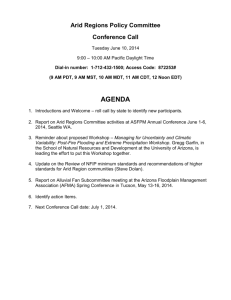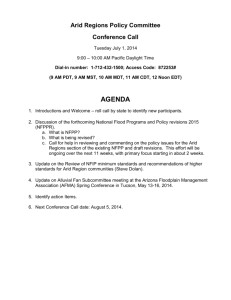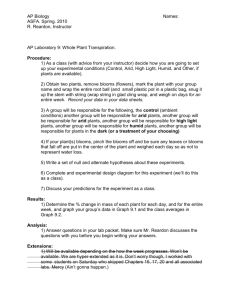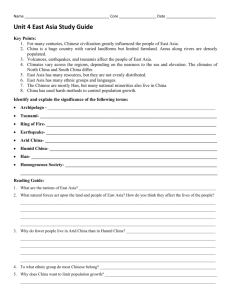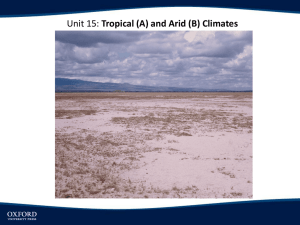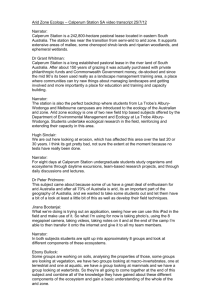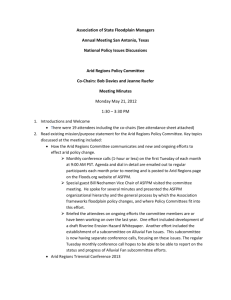Document 11859506
advertisement
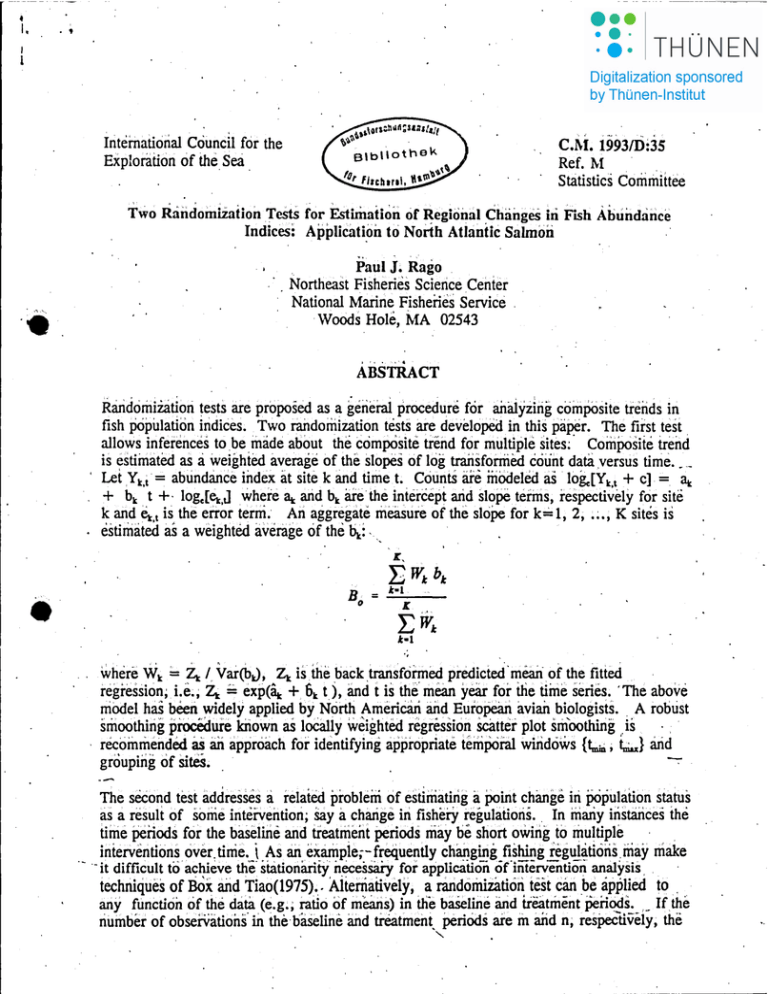
•I.
. ,
International Council for the
Exploration of the. Sea
C.l\l.
1993m:3S
Ref. M
Sta.tistics COrluniitee
1'wo RaridomiZaiion TeStS for Fmunation of Regional Chänges hi Fish Abundance
Indices: Applicati~n tri North Atlantic Salmon
.'
Paul i Rago
Northeast Fisheries Science Center
National Marine Fishenes Service .
.Woods Hole, ~{A 02543
..
ABSTRACT
Raridomizatlori tests are proposed as a genefaI procedure fcr. ariaiyzirig comPosite trends in
fish pcpillatiön indices. Two randomization tests aredevdopcil in this paper. The fiist test
allows inferences to be Imide about the compcisite trend for multiple sites: . Comix>sIte trend
is estimatoo as ci weightoo average of the slopes of log traiisfonrieci.ccunt datä yersus time. _,_
Let Y k,t' = abundance index at site k and time. t. CountS are mooeloo as .lo&[Yk,t + c] = ~
+ b k t +. logc[~,J where ~ arid bk are' the intercept arid slope terms, respectively for site
k and ~t is the eITor terni. An aggregate rileasure ofthe sl0Pe for k"':"l, 2, .:., K sites is
estimated as a weightoo average of the ht= '"
'.
.
X,
B0 =
EWtbt
-x-t-l
EWt
t-l
"
where vi" = Zt (Var<bJ, Zt iSthe back.trai1sformeci prooieted'mean' of the fitte<!
regression; Le.; Zt :'exp(~ +6k tj, and t is the' mean year for ilie time series. 'The above
model haS Ileen ~dely applied by Nciftb American arid European avian biologists. , A robust
smoothing pIucedure kiiown as loCa1ly weightoo regression scattei plot smoothing ) s , ..
recommended as an approach for identifying appropriate tempciial wiridows {tm.ai; ~} arid
groupirig of SiteS.
The second test adctresses a related problem of estlmating a i>oirit change iri popul~iion status
as a resuIt of some intl~ivention; Say acharige in fishery regulations' In riiariy inst3.rices ihe
time penods for the baseline and treatment periods may be short owirig to multiph~
,
interventions over. tinie. \ As an exarnpie;- frequently changing fishing regulatioris .maY niake
'- '- it difficult to' achieve the- stationaniy n,~~ssaiy for applicaiiön <>r"intervention analysis, '. '
techniques of BOx arid Tiao(1975).. Alterriatlvely, . a randorilizatiori test cau be applied to
any functicinof the data (e.g.; ratloof means) in the baSeline and treatment' PenOds.,_ Ifthe
number of observations' mthe'baseline and treatment, periOds are mand n; respeetively, the
<
"
ratio of means can be defined as:
"'+ t
lI
X
1':
LL~
k-l ,-",+1
x
"'t
nk
1':
LL~
k-l ,-1 mk
The sampling distributions of Bo and R" are enumerable, but can be approximated by
randomizing the count data for each site and computing a new value of B and R for each
iteration. The probability of obtaining the original observed value Bo or R" can be
approximated by direct comparison with the sampling distributions of B or R , respectively.
Randomization tests are useful for assessing changes in stock status because such tests
require few assumptions, the results are readily interpretable, and the sampling distribution
of the test statistic can be easily approximated on a portable computer. To illustrate the
utility of the randomization tests, the methods are applied to Atlantic salmon count data for
rivers in Atlantic Canada summarized in the North Atlantic Salmon Working Group of ICES.
2
'"
,
INTRODUCTION
One of the common problems faced by fisherybiologists is the assessmeni of polmlatlon
trends. Of the many techniques available to evaluate long term trends, ihe Box-Jenkins time
series rriodels (Box and Jenkins 1970) have been successfully applied to menhaden (lensen
1976), oysters (Ulanowicz et al; 1980), rock lobster (Säila et aL 1980); and haddock
(Pennington 1985). LOng term time series, however, are the exception rather thän the rule
in fisheries assessmenL Changes in management, fishing effort, or environmental conditions
can act singly or together to confound the iriterpretation of long term time series. AnaIyses
of lang term datei is instructive, but detection of recent trends « 10 yr) cind responses of
populations to management interventions are often more immediate management concems.·
Other methods of assessment .are necesSary when the number of observations is small or
when assumptions eire difficult to test.
For inany fish spedes, and .Atlantic salmon iri particuiar, one or inore indices of aburidarice
are routinely collected at widely distributed sites under a wide vanety of conditions. , If such
rrianitonng programs are P:lIt of an overall scieritific sampling. program;' sampling theory
can be applied and the abilitY to detect change is governed by the precision of the survey.
\Vhen si>ecies are distributed widely across regions or ,couritries; scientific sur-veys eire .
difficult to implement. Nonetheless, speeific stUdies tend to be consistent across years,'
allowing within series compansons. Comparisons among series; however; cari be hampered
by varyirig methodologies and unkltown biaSes. Under theSe cu:cumstänces, randomizatiori
tests .can be used to rriake iriferences about popuhition
status.
. .
.
. R~doiniiäiio~ tests were first proposed by Fisher (1935) but wid~spread application has .
beeil stimulated by the ävailability of roicrocomputers. More recent treatment of the theory
lllay he found in Lehmarm (1975); ieeerit applicaticins "may be found in Soms (1977),
Rosenhaum(l988), Ru (1989), ManIY. (1991), and Raz arid Fein (1992). Randomization
tests utilize the infonmitlon contiiiriect inthe tempoIil order of "the data wiihout making
unreallstic, assumptions about the eiror distribution.. RaridciiniZation testS are partlcularly
weH suited foi- assessirig changes in stock statUs because such tests require few assumptions,
th~ results are readily interpretable, andthe sarnpling distribution of the test statistic can oe
easily approximated on portable comlmter.
. "
Circumstäriees that ronfound the interpretation mdex data for
arid otlier fish ,
species are germane to äther wildlifepopulations. Avian' biologistS have.recently developed'
techrnques for aSseSsment of avian abundance (Sauer arid Droege 1990) which emphaSize the
use of graphical techniques for exploratory da ta änalyses and "route ~egression äiiaI~sis"~'
Route regression analysis haS been iised to aSsess aviari Population tiendsover broad "
,
gecigraphiCal regions (Geissler änd Noon 1981; Geissler 1984). "Route" tYPicilly refers to ä
time series of bird countsat ci pwcular site.. A collectlori of "routes" along broad . .
geographical region consütutes a f1yway~ : Route regressiciriänalysis ures a generai linear .
model toadjust count data fcir observer biaS arid ta .estimate ,within-röutevariability.. A'
coriipösite estimate of trend is develoj)ed arid jackkrii~uig or bootstrnpping techiliques are
a
"
oe
3
Sälmon
r
~----
-
-
-
-
-
,
i
I
I
t .
,
':
-
'-,
,,'"
I , .. ,.
'.
"
' . .
.•..
'I
j
"',
'.
j
"
'.
<,.'
'
•
,
employed to estimate its variance (Geissler,and Sauer 1990). '. Alternatively, .Collins (1990)
has recorrimendect the use of re-randomizätiori to approximäte the sampling distribution of
the composite slope estlmate.
!
.
.
'.
...
. "
"
',",
,
-
,,,.
'.
",e,
"
I
.
"I. ' ,
.. ,
,
. ' " ,.
"
.. , .
"
In thiS paper I apply the general dass of route regression models to Atlantic salrrion data,
utilizing the randomization approach of Colliris(1990). . I theri develop a complementarY
model based on the ratio of means between a baseline and treatment pericid for multiple time
series. .The statistlcil1 power of this ratio test is examincid with sirriiJiated data. Both mOdels
are applied to estimated returns, of Atlantic salmon to monitored rivers in Canada. '
Microcomputer software to apply these models has beeri wrItten and is available upOn
request. '
:\
~iETliODS1
!
;
i
Anai~~isof tlrrie-series data .ror trends caribe envisio~ed as three distlnct steps: ,:' ,
identificatiori, grouping, aitd hyPothesis testiiig. Ideritlfication aitd grouping can oe facilitated
with robust smoothing äpproaches (HippeI and McLeOd i989, Raz 1989, Taub 1990,iarries
et 31. 1990).
I
'
,
.
':
"
.'
,
'.
,
,',
"
,
I , .
., ,
'.. '
Identification is theprocess by whichthe underlyirig signal (e.g., trend or cycles) is .
distinguished from the noise (i.e. random errcii'). Autocorrelation and differericing methOds
(Box and Ienkiris 1970; Nelson 1973) may have limited utility when time series are short iri
, duration or have missing vaIues. ,TestS of statioriaritY and norriialitY assurriptions will; .. "
~ypi~IY,have low.po~e~ im,der these circums~ces .. .StCl?~tlcal ~n,1oothing p~~~ies ~o
not make strong assumptions about theunderlyIng dIstribution of error terms." Smoothing is
especially usefulwheri deteetion of short term trends is iriiportarit. .Recently developed ",
graphiCäl methOds (Chambers et aL 1983) have a strang thooretical ba.sisand Clllow for visual
exäffiiriation of shört arid long ternl trends. LOWESS', the acronym for "löcally weighted
regression scatter plot smoothing" (Cleveland 1979), teeliriiques fall into the generiil: .
category of "robust" statistiCal proeedures which~ in geneial tenns, are resistant. to oütliers.
Other smoothing approaches such as kernel estimatlon (GaSser and Muller 1979) or :
smoothing splines (Silverman 1985) could be used. l
"
'
t
,
I
When it iS desmmie to. niake inferences atiout brOäd g~griiphica1 regions, LO\VESS :
smoothing can also aSsist in the identification of systems wÜh siinUar oehaVIor arid facilitate
groupirig~ ,When tWo systems are behaving siffiÜarly:over
same
time interval,' ,a, "LOwEsS
1
'."'." . • .',. .'( ...".
•
P3.lrwlse plot of one times senes against another wIlll have straight lIne segments~ Dunng
time peri()(1s iri which !Wo time series have divergent ~esponses; the LO,wESS plot Will be
.emtic.
Similäi
behaVicir
arnong time
series" suggestS,:but
dees not confmn;
siiniHir
.:. '
"
" ••
' "
"
".,
.'
' . .•.•
' . ,L
•
' "
.,
•
•
underlying factors arid may aid in identifying causative factors. More formal stattstical
mOdels for grouping such as cluster analysis 01' prlricipal comPorients .ana1ysis eould be
applied but robust graphiciU teehniques are suggestoo as the appropriate first step.· '. :
N
.'
•
"~
•
"",",
<~ :
.C,"
• • ,.
....
'.'.
.," .)
...,
"
. , ' , .-:
,
,'~
,.".
I
4
e
,~,
•
Identification and grOliping suggest appropnate time intei-vals arid combinatlons of systems
cPopuhitions) which.can then be examined with route regression analysis or the ratio test .
descnbed below. All graphs were prepared usirig SYGRAPH (Wilkirison 1990a), which is
part of the gerieral statistical pacbge SYSTAT (Wilkiris~n 1990b). '.
Model bescription: . Route Regression
•
The objective of foute regre~sion is to make a probabilistic stat~ment abcitit the compösite
trerid for some subset of the populations iirider considerntion.. Consider a set of count data .
in whi.ch Yk,t derlOtes the cci~nt of fish at site k and time t. .
Y1;mia
y.
l,tmla+1
Y2.t".a . Y~·1
...
Yl,t~
.... Y1,M+IJ
Y2.tmu
....
...
•
Y2,Iii+IJ
....
Suppose we are iriterested in' drawirig iriferenees .abciut the coinposite trend in aburiclance for
K sites over some subiriterval {~, tmü} ,within therange t "1,2, ... , T; where T = m+n.
. A generaI statisiical riiOdel for count data Yk,t is of the form
(1)
where ~ and ht are constantS fcr site k arid fk,t is the errcir tenn. The muitipiicatlve eiTor
strUctUre ieflectS the coinincin phenomeriä whereby the variance excee<ts the mean arid
'
increaSes wiih it. Transforrriations areciften necess3.ry to. stabilize the vanance and to more
elosely meet the aSslmiptlons of generäI linear models (Neter et aL 1990). Although there is
much literature on the subject of statistic3.J. tcirisformaticinii (e.g~ BOx and Cox 1964); the .
most corririiolily usoo tiarlsforrriation for count dati is of the form 10~(Y + c) .where c is .
someconstant. A simulation stUdy of courit databy Collins (1990) suggested that c=0.23
would yield the greatest probability ofcorrectly deteetißg both soort (5 yr) 3.iid long term (20
yr) trends. Colliris~ conclusions were based on random sampIes drnWn from a negative
binomial mOdel with different meän densities ärid different levels of the äggregatiön
parameter "(. In Heu of a similar study for fish counts, a vatue of c~O.23 is usect herein.
The transfonned liriear modelcorresporiding töEci~ lis
.. ..... ...
The nexi step in route regression is tri ootain an estiinate of the overall trend (B) among the
5
.
. "
,
,
10ge[Yk,t +. 0.23] ~ loge(a.t)
.
,',
'....~.
.
,
",
' "
-'"
'.
(2)
'.
.'
:
-
.
:,
,
. '
~
'.
K sites. Estimates öf ht över the time irite~al tmm to tmai are obtainoo. via Eq. (2); missing.
data with a time range can be iric0rPorated ioto theestimate of ~" Temporat vmabiUtyand
the, magnitude 6f the time series have importarit implicauons for the deteetability of the true
underlying trend. Simple ayeraging of regression sloi>e parameters would be apProPriate.
only if all of the systems had equal temporal vanability arid all time series were similar in
magnitude (Le.; a1 == a2 ='; •. = äJ:' A basic tenetin route regression is that slope estiriüites
eire wdghied inversely by their variance ,arid proportiorially by the magnitude of the series.
1!98~,
ha~~ pr~po'Sed 'a
Aviari biologists (Geissler anct Noon 1981;" Geissler
CoIiins 1990)
weightect average estiriiator ofB I
•
'
I
!
K
:E Wj; bj;'
!
"
Bo = j;-1
,
,
, .,
(3)
i
where Wt -:- 4/ Var(bJ. Collins (1990) recomme'nds estimating 4. as the back
transformed predicted riiean of the fittoo regression fr~m Eq. 2. Thüs
,
.
'.
,
Z~
,
= e[4,t';' 6,,'i,)
..
,
I
,I .
I
(4)
01
II
, ' I ,
,
,.
,.,,'
where t is the mean year for the time series. Sevefal riiwures of the variance,of the sloPe.
have ileen proPü5ed,(Geissler iirid Noon 1981, Robbms et aL 1986, Geissler 1984) but ,
Collins (1990) noted thai Var(bJ cari be urireliable when the number ofobservations are
sm3.IL Jarnes et aL (1990) recommend additional work on this aspeet of route regression
analysis.,
, , "
. "..
"
;,
, '
,,
'~ .
.
,
'
,', , ".' ,', ,', ' ,.. ' ,
I",,', " ' ,
"
"," ,
siatisdcäJ. iriferences abOut the observoovalueof B c3Ji be made by approXimatirig its~ ..
sampling ~istiiDUtion ',usmg bootStrnpand jackkriife teehniq~es (Geisslei arid Sau,er 1990) or
re~rändomiiiiiciri (Colliris 1990). In ä fa!ldoinization~model theproblem is stated aS; "Urider
the null hyPothesis tliatthe obserVations (Yk J aie 'i'andorii!y örderedwithin each
whät
is ,the probabilit}r of obiaining a value of B greater.than or eqUaJ. to the observed Bo?~' In
oth.er words, is theobservect time
simply a rändom ordering of observations o~ isthe
obseiV~ vatueuniikeiy?, If the obserVed value is unllkely, then it may provide evidence of a·
iriie chang~ in the undedying Process. '
' :
,
senes,
series
.
The randomization approach allows us to quantify,
.
.
.
6
:
.
ho~ unlikeIy B~ is by approxlmatlng itS .
II
'. '
'
•
sampling distribution. Each time series Yk•t is randomly shuffled and a new 6k,i estimate is
obtained, where the i refers to the i-th of rea1ization for the k-th series. The weighted mean
slope for each rea1ization is denoted as Bi' The process is repeated an arbitrarily large
number of times, say N, for each of the K time series and the sampling distribution B is
approximated by the set of Bi' The probability level associated with the obseived B is
simply the number of Bi < B divided by N.
. f\.~odel Description: Ratio Test
•
.' ,A related problem to route regression concems changes in mean' abimdance between
two' periads of time. The first' periad of time is called the baseline periad and consists of m
years (t= 1, 2, m); the second period is the treatment periad consisting of n years "
(t=m+ 1, m+2, m+n). The general.data matrix. for these problems can be wrltten as
(Yk,t)
=
Y1,1
Y1,2
Y21
,
Y2,2
...
'
Y1,111+11
Y2,111+1 Y2,111+2
Y2 ,111+11
YX,III YK.M+l YX,III+2
YX,III+II
Y2,111
YX,I YK.2
.
Y1,111 Y1,111+1 Y1,111+2
Consider a simple example in which one wantS to compute the ratio' of mearis between two .
periads of time. For a single serles k the ratio of the means for these two perlads can be
estimated as
.
R =
(1
(5)
i: Y,.
,-I
m
Usual t-tests could be used to draw inference for such ä prob~em, but testing assumptions of
independence of obserVations and equalit}r of variances might be difficult, especially when
n = 1. ' Here again, nindomization tests can be used to approximate the sampling distribution
of~.
.
,
For any single time, serles the number of possible orderings is obtained as the combinatorlal
. of m+n with n. . For K time senes the number of possible orderings increases ,with the
number of time serles such that the enumeration of the sampling distribution ~f R, consists of
7
Q pössible obServations where
"
Q =
(m;n)l
(6)
\
1
In general terms, the resolution of the test (Le., one lover the number of possible outcomes
is determiried by l/Q. As the number of time series increases, the resolvirig power of the
test can become very fine if ties or missing values da not predominate the time senes YIr t'
In practice. the sampling distribution of Ro can be app'roximated by generating a subsampl~ of
1000 or more ~ us~~~ rand~~iZation procedures.
'~~
I . . ..
..
•
The simple mOdel in Eq. 5 can be generalized to K time series as follows
,
' I
Je
m+llk
E:E
" R=
o
t-l '-m+l
Je ,mt
1': .
2t
nk
(7)
1':',
EE-5!
m
t-l ,-I
k
I
, ,
I
The advantage of formul~ting the ratio as in Bq . 7 is that large counts contribute more to the
ratio than small counts. Note also thät Il1t oS. m, aod that nlr ~ n. The values rrilr and nlr
will equal m and n except when missing values are present.
., . . " .
l
,
, ",
"
i
'
I
staÜstic3J. Power of Ratio Test '
I
I
.
I
.
The statistica1 power (te., the probability of correctIy~ identifying a true change) of the ratio
test was" evaluated .with simulated data. Simulations for power calculations assumed that the
underlyirig count <Iata YIr t were distributed as negative binomially distributed randorri
variableS. The following parameteriiation of the negative binomial distribution by Bliss and
Owen (1958) was used:
;
,
i
I
'p[Y ='
y]
= r(y+y-l) (' y ~ ) (1 +Y
y! r(y-l) 1+y ~
1
JI)-1/1 '
(8)
,' ,
wheie the parameters Pt and 'Y,represent the mean and dispersion parameters, respectivelY.
The expected value ofYt = E[Yklt] = Pt,t and the vanance of Yt,t= V[Yt.J = Pt.t +
'Y{p.Ir'J2. : . The disPersion parameter.'Y was set equal to 1/10. As the gamma function
r(x+ 1) for integers simplifies to
(Mood et' al. 1974) and Eq. 8 simplifies to,
x!
"
8
:
•
.
P[y
.
= y]
(9)
Pseudo-ranrlom ilUmbers ~ere, gerierated from the negative binomial distrÜmiiori were .
generated using the methcx1 described by Piegorsch (199i) . 'The foiIowirig equation was.
solved fo~ the minimum value of ] that satisfies the iriequality .
. . ' .' ,
u ~ t(~-~)
(i+y
'K-1
X&1C
J1flC ( Y J1
1+y J1
r-
IC
(10)
where u is a uniform (0,1) raridom number, I( ~ ''Y- 1, imd 'Y is resirided to integer ~aiues.
The negative binomial rarid6m number y equals ]-1(.
Two aspects of Power were considered. First, the effeets of adding additional time serles
were inves~gatoo by lettirig K vary from 1 to 11 by incremeniS of 2. " Tlle baseline i>eiiod
was assumedto have eight years (Le., m=8) of obserVations whill~ thetreaiment period
consiSted of ~ yeai's (Le., n=2). Changes in the underlying mean for the treatment j)eriOd '
were niOdeled as'
.
,
.
•
,
{~
"
J1k.,t
,
=
fOT k=l;~~.;m
iL+lt. IL •
r-
u,..
fOT
".
k =m+l,
~;~
.
l1'+n
(11)
.
.i"'~
To investigate the abilitY of the estimator to correctly detecit increases arid decreases i~ the
"
The seCond aspect of power was the ability of the ratio test to deieci chariges of ~agnitude
0
ineari I let 0
= LI,
1.1-1; 1.25 and 1.25-1.
fora fixe<! number öf series(K;:;;5) and ä "t}ipiCal" set of baSelirie Irieans Itt .- {1250, 625,
590, 300; 50}., The baseline means were arbitnirily chosen to span tWo orders of magnitude.
The step change p3.rariieter
1.3-1,1.4-1,1.5-1, 1.75-1, 2-1~
Ö was
set to 1.1, 1.2, 1.3; 1.4, 1.5, 1.75; 2, and 1.1-" 1.2-1,
'
.':
Applicätion of Route Regres'sion to CountS of srhäll Salm<>" 3.t Index Rivers in Cari.adä
. ~Ürice i984 Canada häs impos&t a seiies ()f increasi~giy: restrictlve rrianagemen.i measures on
Ätlantic salmon fishenes, culminatlI1g.with the closure öf fisheiies in insuhli Ne~foundhirid.
in 1992 (Friedland 1993)., 'The Nört!i' Atlantic Sälmon Warking Groüp. (Arion 1993, Table
2.2.3.1, Fig. 3~3. 1.3) 'graphically summ3.ri#d count daia for "sman" s3Jmon in 21 riyersiri
AiIantic Canada using srrioothed Z-scores~ Sman salmon are fish less than 63 cm length arid '
9
•
I
,
I
I
I
I
{
,
J
l.
,
. .
'
typically, fish which return ,after one year at sea; Rivers were.clüstered into 6 geographicaI
regions with 3 or 4 rivers in each. To quaniify the compOsite trend in each of these regions
I applied the route regression model to the 1984-1992 count data listed in Table 1. Data were
'. analyzed using the computer program ROUTE.EXE (available uiJon request).
Application of Ratio Test to Returns of SrriaIl arid
Jge' Salrii6n to NewfoutlclIand.
I
.
,
The ratio test was applted to the estimated returns of small and large salmon to selected
Newfoundland. ,rivers duririg the period 1987 to 1992'. The purposeof the test. was to
determirie whether the closure of fisheries in insular Newfoundland i'n 1992 had any efTect on
returns of small and large salman t6 the Humber River, RockY River"Tem Nova; Middle
Brook, Biscäy Bay, Northeast River (Placentia) arid the Conne Riyer (Table 2). "Lafge"
saImon exceed 63 cm in h~ngth arid comprise multi-sea winter adults, arid repeat spawners.
For bath groüps; 1992 observatioris were compared to the 1987-1991 mean.
Data fcr
small arid large returns were analyzed separate1y using the computer prograiri
NPRATIO.EXE (available upon request) .
I '
, ' .
.
t·,
l -' •
_
.,_
.'~
:,
I ,
•
i:
......
>,
,
:< •
~
• " "
'
,',
,'",,,"~'...
I
i· ' , "
'
'
'.
. . '
•
I.
,
: •
,
' .
'
•
REsULTs'l,
I
Api;ÜcaÜori pf Route RegreSsiOn to CountS of smah Salrrion at Index IDvers in Canada "
,
' I
.
cf
'Route regression analy'sis coünt data for smäll suggesied a variety 6f trends by region
(Fig.. 1) In southem Newfoundlarid counts Pf smaIl salmon have decreased significantly
over the time periOd (P <0.0002, Table 3). The decline in the Conrie River dominates the "
estimate of corriPosite trend for this region. In contraSt,. no sigruficant trend was evident in 3
~estern Newfoundlandrivers ,(p=0.4760) 01' 4eastem Newfoundlandiivers (P=0.784). '
Movirig to the. rlOrth shore region of Quebec, counts of srriaIl Salmon also revealed no '
significant trend (p =0.1982) aver lbe 1984 to 1992 periOd. No sigriificant trend was .
estiimitoo ror Scotia:Fundy Rivers (p=0.6344) during' this perioo. . Small Salnion iri,tlie'
large rivers of the Gulf Region, particularly the Mmichi River, appear have increased
significantly during this periOd (p=0·9458).
,.
. '
.
ApphcatIon of Ratio Test to Returns' of Small and Laree
Salmon
to
Newfoundland,'
"
'.
,
to
,I . ,
"
'," '.'
•
'<
J'~
,_.
,_
•
,
_,;"
. " .'_
"
•• "
;
_"
'.
.'....
:
"
~T'
,~
Co...
... ',
,_
• ,," , .
l
• '
.~
,'_
...,' " "
i•.'
'..
-."
,_ '. 7. .
.
.. '
. I;
"
,."
(
•
"
.-
,
'..,.
.~"
•
,j\
"".,;.,
,~.""
-
,'_"
"'i"
•
,':"
I , "',-;
i';'.~ ~
' v , • • . , ._ "
,
~
..... '.-.,
I
-. . _,:
.,-'•.
'
~'.,
,.
Results ofthenonparametnc ratio test suggest that the probabdlty of the observed ratio. of
1.46 ul. SITl3.ll
returns is about 13 % (Table 4). : Thuswe would. fail to reject null .:
hypcithesiS and coriclude that no signifieant increare in small salmon ,returns hcidOccuiioo.
In contrasi the observoo ratio. forlaige,satmon of3.91 hada probabilitY level of 0.035 .,'
(Table 4) .TIiuswe would concIude that IargeSaImon.returns were significantly higher in
1992. ' Pre~umably, ihe increaSein
of large SaImoriwas attributable to cessatlori cf
coastal fishenes in Newfoundland~. As the coastal . fishery has been CIosed foi oniy'oneyear
contimied
monitoririg should
improve the 'statistic3.l Power to .detect changes in abundance. .
.
' ' ' .
,I
Salmon
retUrns
..
1
,
•
".
•
anal
Results of ~e power
yses illustrated' the expected .increase in Power as additi 0 mil sites
were added to the 'analysis and decrease in power for 'smaller a~ceptable levels of Type I
statlstic:al error (a) (Fig. 2): The ability to correctly identify increases in the mean of 10%
(Fig. 2a) was less than 60%, even when 11 sites were considered and a was set to 0.20. At
more commonly used a levels (0.05, 0.01) the nonparametrie test would have apOwer less
than 30%.
In coritrast
increase iri the riiean level of 25% could be correctly detected
60% of the time when 7 or more sites were examiried and a = 0.05 (Fig. 2b).
Sirriilar
conclusions apply to decreases in the mean of comparable mägnitudes (Le., 1.1-1 and 1.25"1
Fig. 2c, and 2dj respectively) .
'
,
an
Tri explore the ability of the test to deteet var)ririg magnitudes of i>ercentage charige i· .'
computed the pOwer for step iricreases riirigirig from 10% to 100% and decreases from 9 to
50 % (Fig. 3)., .' The plot reveaJ.s the symmetry of Power estimates for increases of a given ,
magnitude or,its reciprocaJ.. For the assumed configurntion of 5 sites, 8-year baseline period
arid 2-yrtreatmentperiod, the nonparametric ratio mOdel could detect chariges of 40% or
more 80% of the time with only a5% chance of incorrectly rejectlng the null hypothesis of .
no change. Acceptarice of a gieater Type I errat: level would increase the Power'
,
substaritially (Fig 3) ;
DISCUSSION
•
Tbe proPoserl iaridomization models appear to be üsefui for drawing inferences about
regional .trerids arid steP. changes in abundariee rar fish Populations. Tbe exarnple
'.'
applications for Atlantic salmon counts allow prob.ability statements to be made about broad
geogniphical regions. The, lack of consistency in the 9 year trends among regions may be
indicatlve of var)ririg life history and migration patterns (fable 3). Difference in significance
levels ror changes in mean abundance,of small arid largesaIrrion in 1992 (fable 4) may
fefleet increased vaiiability of small salmon counts.
An appi'äisal ofthe potential causes .
, ror the variations amorig geographie regions oi sire groups is.beyoöd the scope of this paper.
Additionäl biological information is necessary to properiy interpret 'potential mechanisms of
change in theSe gröups; ,Tbe nmdomization mOdels howevei, provide iriteresting startlng
points ror ev3.IiJation of hypotheses.
.
'
Corise~atlori cf flshery resources cleinarids thai downward trends be, detectoo eariy so thai:
management meaSUres can be taken. Identification of long term cycles is useful for
retfospective ari31yses büt pnor cyclic behavior does not giJarantee that ä decimated
contemporary Population Will rebound to earlier highs. Thus, detection of trends over
periods of less than a decade is impoi"tant: . In a similar faShion, it's important io detect the
effeets of management actions on population statUs, parucularly when coriserVation rrieasures·
incur considerable e x p e n s e . . '
. .
The randorriizatlon mOdels are conceptu3.llY simple arid their apparent statlstlCai power for
simulatoo dat3. (Fig. 2, 3) is ericouraging. . Similar caIcuhitions with actuaJ. data could be
used for estimating least detectable rates of chänge.. For example, suppOse ihat m baseline
.
,
.
11
•
···
j
.
I
years are avallable for K sitt~s and one is iriterested iA the magnitude of change that would' be
detectable in n subsequent years. Random data sets 'could be constriicied iri which the n
values are randomlY. seIeeted from the in obserVation~. ät the k-th site. Bach cindomiy
selected value would be multiplied by'o andthe significance level ror the denvect criticai
value~ of the appended data set of m+n observations could be estimated. The immber of
iimes t~at the null hyj)othesis was correctly rejected ~ould be a measure of the power of the
test. Hence päwer analyses could aid in the design and evaluation of mariagement
.'
expenments.
i
,
'H.
I
.,
"."
I
'
.
'
Power analyses for the route regression model were ~ot corirlucied. Titus et aI. (1990) have
recogrüied this as an important area of research. Simulation sttidies of Geissler and Sauer
(1990) suggested that trend,estimates baSed On less t~an 5. years of data may be biased.
model to shöit .time senes. .
Therefore Cautiön should be exercised when applying;the
I
. .
.'"
, ,, I
. '. .
•...,
,
'"
Both the route, regression arid ratio raridoniization models could be expanded to consider 110ncount data. The units of measure arnong sites should' be commensurate arid cilternatlve
, wdghtil1g factors (Wt ) would be employed. For exampie,'
lengths of fish at different
t
sites might be investigated for, evidence ofchanges in growth rates or gear selectivit)1 over
time. \Veighting factors could simply be the samplesize for each site, the stratum size, or
totalcatches withiri a stratum or site. As noted earlier,the choice of weighting factofs is an
active area of current research in avian biology applieations of route regression~ Applicatiori
of the randomizärlon tests to time senes with non-eommensuIite uriitS should be done
cautlouslY.. Observations withiri each site k could be standardized but selection of weightlng
factors could .stronglY äffeet the outcom~ of the test. I '
.
. '", .
mean
. " ..' " .",.,,'. ., . ;'. '" ,..", ,.,' .....".. L ,.' " .
"
. '.
'....,., .,
Trend analyses in other areas ofenvlronmental science (e~g.,Anon~ 1991) should also be
reviewed for potential application to fish population aSsessnient.', RaZ (1989) haS receritly
extendoo .the theory for repeated rneaSures, designs oy incorporatirigrandoniiZation and
smoothingcompönents. His results showthat smoothmg incre3.Sed"the power of the. tests for
time effectS' and groüp by tirne)ntera6tions. Nonp~etric smoothing approaches have.' .
been advocated by Taub (1990) arid
et eil. (1990) for an3.lysis of bird populations, .
HiPPeI arid McLe6d. (1989). for wäter qualit}r data. The. generalized additive mOdelS of Hastie
and Tibshirani (1990) illustrates the geneialitY of smoothing for aSsessmerit of broad dass
of problems." Fin3lly, the randomiZation mOdels described by Maiily (1991) should firid . ,.
general applicability' to fishenes science.
. 1
. .
Jarnes
a
.
I
..
I
I
I
\
..
I
!
1
,
·I
I
I
12
I
:
!
I
I.
"
.
......
•
.
----------
~---~-~~~-~---
REFERENCES
Anon. 1991: RepOrt of theWorkirig' Group on StatistiCal Aspects of Trend Monitoring.
International Couricil foe the Exploration of,the Sea. Copenhagen. C.M. 19911POLL:
, 2.
•
Anon. 1993... Report of the Working Group ~ri 'North Atlailtlc Salmori. International Council
forthe Exploration of the Sea. 5-12 March 1993, Copenhagen. Doe. C.M~
.
1993/Assess: 10.,
"
.
,
.
Bliss, C. I. and A. R. G. Owen. 1958. Negative binomial distributions with commori k.
Biometiika 45:37-58.
_
Box, G;E.P. and G. C. Tiao 1975; Intervention anaIysis with applications to economlc an<!
environmentaI problems. Journal of the Americari Statistical Association 70:70-79.
Box, G. E. P. and 0. R. 'Cox. 1964. An'analysis
Statisticitl Society B 26:211-252~
cif traltsf6-rmati6ns. Journai of the Royal .
,
Box, G; E.' p;' «u.id G. M; Jenkiris. 1970. TIme series analysis, forecaSting and controL
. ' Holden-Day, 106., sari Fcincisco; CA, USA.
'.
,
,
Charrihers, i. M., W. S. Cleveland, B. Kleiner, and P; A. Tukey. 1983. Graphiciil methOds
for data analysis. Duxbury Press, Boston; MA, USA.
'.
Clevetarid, W; S. 1979: Robust lcicaIly-welghted regressiori.and sm60thing scaUer plots.
Journal of the Anierican StatistiCaI Association 74:829-836.
Collins, B. T. 1990. Using rerandoniizing testiiri route-regression analysis ofaviari
population trends. pp. 63-70. in J. R. Sauer and S. Droege, &iitors, Surv.eY designs
. and statisti6aI methods for the estimation of avian pOpulation trends. U; S. Fish arid
Wildllfe Service, Washirigton D.C. BiologicaJ. RepOrt -90(1), 166. pp.
".
FIsher, R;
A.
1935; The design oi experimentS. Oliver arid BOyd, Edinimrgh-Lorldon (1st
ed. 1960).
ed. 1935; 7th
Friectland, K. D., i993; History of salmon flsheriesand managementm the North Atianiic.
Ninth ICES Dialogue Meeting, Edinburgh, Scotland. International Council foi tlle
EXploration of the Sea; Copenhagen, Denmark.
Friedland, K. D. and
,
0.
G. Reddin.
sea
1993. Manne survival of Atlaritic salmon from iridices
'of post smolt growth and
temPerature. Foiiith Intematiomu AiIäntic Salmon
SympOsium, St.Ändrews, Canada. (in press).
13
•
,
Gasser, T. and H.-G. MuIier. 1979. Kernel.estiniäti~ii of regression funclions. pp. 23-68
T. GäsSer arid M. Rosenblatt (eds.) Smoothirig techiiiques for cUrVe estimatiori.
. Springer-Verlag. New York.
. I
',,.
,
,
,I·.
..
in
.:
Geissler, P. H. 1984. Estimation of animal population trends arid annual indices froin a
,
survey. of call courits or other iridications. proc.Amer. Stätist. Assoc., Sect; Surv.
Res. Methods 1984:472-477.
I
!
,
I
Geissler, P~ H. and~ B. R. N:cion.. 1981: E~timaÜ~s of:avian pop~latiori trerid~ from 'the Nohh
.Ainerican Breeding Biid SurVey. Pages 42-51 in C. J. Ralph aild J. M. Scott, editorS.
.
Estimating the nurilbers of terresti'ial biids. Stud. Avian Biol. 6. "
• ,',
.. ,'
, " '.
" ' , ' '. ,' •.• ",1,.
'", ..•. ,,'. ,.' ::..
,'.
Gelssler, P. H. and J. R. Sauer. 1990. TOplCS In route-regressIOn analysIs; pp. 54-57. iri J.
R. Saüer and S. Droege; editors, Survey desigris and statisticä! methods for ihe
,
estirriation of avian populatioritrerids.U. S. Fish andWiIdIife Service, Washington
D.C. BiologiCal R~~rt90(1), 166 pp.:
.
i'
,,
. ""
,,
•..
"." , ,
- ",
I
.
,.,'
Hastie, T. and R. TibshiranL 1990. GeneraIized additive models: Chapman and, H~l;
. '
I
London.
. .
•
,
, .
• .
.'
I
•.
,
. ,
James;
F.
C.,
C.
E~ McCuIloch, and L. E~ Wolfe.. 1990. MethOdologicill issues in the .
.
.
'." . • .
'-. c'
'.
. , '.
'.'
,.
• ..
:. _
_
estimation of trends In blrd populations Wlth an example: the pme warbIer. pp. 84~97.
in J. R. Sauer arid S. Diciege, editors, SuiVei, desigris.äiid stätistical methOds for the
'estimatiori of aviari population trerids; U. S~ Fish and WiIdIife Service, Washington
D.C. Biolögicill RepOrt 90(1), 166 pp.
!. . '
"
.
,
~.'
~
: .
I
",~
.1.,-, .'
, •
•.• ;'
I
,
I
. '.. •
_ •••
~."
..... .,
'-,
t
·
Jerisen; A:L: 1976. Time senes arialysis arid forecastlrig of Atlaritlc menhaden catch.·
i
..
Chesai>eake Science 17:305-307.
. ..'
"..' .
'.
. I " .
". .
HippeI, K.W~ and A. L McLeod. 1989. lriterventio~ analysis in environmental engineering.
Environmerital Monitoririg arid Assessmerii 12:I 185-201.
.. ._ _.
.
,
.
.
.
....
E. L. 1975. Nonparametncs: St:iiistiCa1'~~ihoos' base<! ~ri rankS. Holden-Day,
. Inc. San FranciSco, CA.
..'
LehrriäilIi,
!
'.
Maniy, B. F. ]~. i991. RandoInization' arid Monte Carlo inethoos in Bioiogy. Chaprrian arid
l'
Hall Pub!.; Loridon~
.
'".
~
,.'
MOOd~
.'
.~
j_
•
_'.'
"
,
I
.
;
• ,.;,
.,'
.;
••
"
,.,
".
'.
'.'_
".,,',
t
.
..' .',
_.
"
..
" '"
.,:.
._..
•.•.
',.00 '.
.
j
. •,
A. M~, F. A~ .Graybill~and D. C. .l3oes. 1974. lritrOduction to ~e theory of statistics.
(3rd edition)' McGrnw-Hill. New York.
'1"
.
I
'"
...,' - " _. 0'
. . ; , ..
".,'.
,!
"
,.
-0···
_..
~
Nelson, C. R. 1973. AppÜed time reries analysis for managerial forecaStirig. Holderi-Day,
. I".
.'.
. . Inc;, San FranCiscö, CA, USA·
,
. '
I'
,
i
14
•
I
=
•
Neter, J.,. W. Wassennan; arid M. H. Kutner. 1990. Applied linear statlsticairriodels:
Regression; analysis of variance; arid expenmental design; 3rd edition. Irwin, Inc.:
Homewood, IL, USA
Periningt?~; M. 1985. Estimating the relative abundarice of fish from äseries of trawi
surveys.
Biometries 41: 197-202;
Piegorsch; W., W. 1990. Maximum IikeIihood estimatiori for the negative binomiai dispersion
parameter. Biometries 4 6 : 8 6 3 - 8 6 7 . ,
'
ReiZ,
i.
1989. ,Analysis of repeatoo measureinents using nonparametrlc smoothers arid
randomization tests. Bioinemcs 45: 851-871.'
Raz, J; arid G. Fein. 1992. Testing for heterogendty.of'evoked potential signals using ari
approximation to an exact permutation test. Biometries 48: 1069-1080.
<_. " ' ,
.
~.'."
Robhins,C. S.; D. Bystfak, and P. H. Geissier. 1986. The breecIing bird sUrVey: it~ first .
fifteen years, 1965-1979. U. S. Fish arid Wildlife SerVice, Resource Publicatlon 157;
196 pp.
Rosenbaum, P. R. 1988. Permutation testS formatched pairs with adjusinu~Ilts for
covariates. Journal of the Royal Statistica1 Society Senes C 37:401-411.
Saila, S. B.; ~f; Wigtiout, arid R; J. Lermit. 1980. Companson of some time series mOdels'
for the analysis of fisheries datä. J; Cons. int. Explor. Mer 39:44-52;
•
.'''.
~
Sauer, J. R~ arid S; Droege. EditorS. 1990. SuiVey designs arid statistical niethods for the
estirriatiori of avian population trerids. U. S. Fish and WiIdIife Service, Washirigtori
ti.C. Biological RePort 90(1), 166 pp.
.
Silverinan; B.' W. 1985; Some aspeetSof the splinesinoothirig approach to nonparametrlc
regression cUrVe fitting. Jourilil1 of the Royal Stätistica1 SocietY, Series B 47: 1-52.
Soins, A. P. 1917. An aIgonthm for the discrete, Fisher's permutation test. Journal of the
Amencan StatistiCaI Association 72:662-664.
Taub, S. R. 1990. Smoothed scatterplot arialysis ofloniHerm Breeding Bird Census data. pp..
. 80-83 iri]; R~ Sauer and S; Droege, editors; SuiVey designs and siatlsticiJ. methods
fcr the estimation of avian pOpulation trerids. U; S; Fish and Wildlife Service,
Washirigton D.C. Biologica1 Report90(1), 166 pp.
TÜus; K;; M. R. Fullet, and D. Jacobs. i990. Detectingtrends in hawk migration count
datei; pp. 105-113. in]; R. Sauer and S; Df(x~ge, editors, Survey designsand
statistic3.1 methods for the, estimatiori of avian population trendS. U. .S. Fish and
15
"
Wildlife Service, Washington D.C. Biological Report90(1), 166 pp.
Ulanowiez, R. E., W. C. Caplins, and E. A. Dunnington. 1980. The forecasting of oyster
harvest in centraI Chesapeake Bay. Estuarine and Coastal Marine Scienee 11: 101106.
Wilkinson, L. 1990a. SYGRAPH: The System for Graphics. SYSTAT, Ine., Evanston, IL.
Wilkinson, L. 1990b. SYSTAT: The System for Statisties. SYSTAT, Ine., Evanston, IL.
•
•
16
•
"maus
Tabie 1~ .Input daia for foute regression ari~ysis. Counts of srriall Salmon for
regions
of Atlcintic Canada. Missing cr partial counts are denoted as -999. Symbols refer to
Figure 1.
.
...
'.-'
Scotia-Fundy Region
.
~,~'"
.
..
..
...
"
..".
... .
~,
..
.
.
.. '
'-
'."
.... ......
•
'.,
~
.-
~
...
.,.
'"
.
,"
.....
29700
. 60800
117500
84800
121900
75200
83400 ,
60900
.,152700 .
~.
....
.....
.,
'
......... ,..
.
• '·'w
.
~
.'
...
.
.'. -
'
ConneC*)
. ...
·999
..
-999
:.
7515
9687
..
7118 ..
.. .......
4469
..
4321
"2086
...,.,.•_.N. . ....
.
.. 1973
.
.
"'..
'"
..
..
'
'
r
...•.
-,,~
-", ,'''',.
..
"
...
,-
.~
,89
124
IS8
......
91 .
......... 97
62
'.-,-'
_n_'
17
..
,',C' . . . ., .. ~ ..... ,,'~ •.
.,
..
.. ..
.
38
27
.
Restigouche (0) .
....
'.
10900
700
10700
10000
13500
6700
13650
7850
14800
.:
...
.'
.
~~,--
....
,>',
,
" ..
~,.
.
.
...
..
. ......
..1,'••
,
.
..
...
..
,
-,
.
Humber(O)
..
..
.-999
' .
-999
..
. ,., ... ·999
12300 . ...
,.
...
16200 ..
.. .
..... _ .. 4900 ..
12200
.... :
..
,...
.
. 5700 ..
....• 22300
.
..
,
'
'
...
.
'."-
...
,,'
.
Biscay Bay (t.)
Grand (0)
.
....
1~" •
~
.. _-
.........
..
."
'"
..
2430
-999.
2516 .
·999
1695
~999 ..
... ....
71
...... 99 "
...... 49
.
..
44
....
~
...
-
,
" ..'
.....-..
.
.-.,,~".-
48
87
.' ,.,' 117 <
88
-- ,76
75
'_T'_'
• • . • ~,~
" ... "
""0
......,
Liscomb (0)
Nonheast Trepassey(O)
'
..
.......
....
.
"0
....
.
Cl.)
117
162
252
. 378
102
. . . . 414
.124 .
233
480
..........
......
...
,<.
Western Ann Broolc
1553
' 2815
2505
2065
.,..... 1339
.... 2296 . .
1415
.
. 2347
••
Miramichi(l.)
'"
~""
.........
,.
,~-,
.'
.....
..
.
......
'~'.
.
_._.
.
1805
I ......
..
'
600
800
..
. .... ,1500 . '
.. 2200
_.800
1000
1900
.. 1000
"'"
(~)
384
638
584
532
380
511
596.
236
215
.... ..
SouthCout
NewfouDdland
1984
... 1985
1986
......
1987
.
.
1988
-,1989
1990
1991
-,-" '".. ..
.. .
1992
. .... ..
••.•••••
'.
Torrent (0)
"
....
400
-
.
....
..
. ....
_.
...
~
"-'."
West Coast
Newfoundland
1984
. , .,' 1985
.. .. ... 1986
1987
1988
1989
.
.. 1990
.
1991
" ... 1992
. ." " >
.
Margaree(O)
~
'..
....
" .
LaHave
8062
8417.
.. ,
6486 .
5415
5729
.....,
_
..
,.,-
,-,~",
5097
Gulf·Mainiand
1984
1985
1986
1987
1988
1989
1990
1991
1992
.
7353
5331
6347
-
_
......
.... 1984
1985
1986
1987
1988
....
1989
1990
1991
1992
.
-,
.
'<
St lohn (0)
..
_
.
·· . .-,.,"c•.___.. _.,,'.''''
. CO",_': "" .• :.,""
.
""" .... ,
,
..
.
.
..... ...
-'
..
1657
_.394
..
.-.. -999
'
...
.
~."
...
I"
..
......
·999
........... '" . -999
211
... ... ·999
149
175
....
208
·999
. .. 101
.'
I
..
"'
Quebec
Madeleine(O)
MitisC*)
"'I
1984
1985
1986
1987
. 1988
1989
· 1990
"',
1991
1992
•
<
239
181
636
225
477
338
528
329
697
East Coast
Newfoundland
Placentia Bay C*)
1984
1985
1986
1987
· 1988
1989
1990
1991
· 1992
419
384
725
-999
543
706
551
353
921
74
156
359
406
499
482
452
461
509
..
Matane~)
-
Trinite CO)
,
,
876
762
2364
1018
692
1208
1270
1586
1877
Terra NovaCO)
Middle Brook~)
1233
1557
1051
974
1737
1138
1149
873
1443
1379
904
1036
914
772
496
745
562
1182
1663
1008
1364
' 1115
1324
1744
1637
1306
449
--
Gander CO),
1081
1663
1064
-999
1562
596
-999
245
1168
•
•
'18
- ------------------1
..------------------------
•
Table 2. Input data for Ratio Test: (A) countS of small-siZed salmon at counting fences of
Newfoundland. (B)counts of large-siied salmon at counting fences of Newfouridland:
.
(A)
~
.... ,
~'.
..
.
Yeai
.
Humber
.
.
,
.
Rocky
,
.'
"
.
..................................
Terra
Nova
. Middle
... ' Brook.
Biscay
.,Bay
Northeast
River
1,400
1,100
1,400
350
10,200
2,100
1,300
1,800
640
.1,600
1,000
.. 810
5,000
1,700
700
400
370
,'....
"
1987
12,300
1988
16,200
80
300
I··
•...
.
'
1989
'.,
1990
1991
.4,900
200
1,400
. - . 600
12,200
400
1,500
1;100
. 5,700
.1992
'.
0
200
22 •300
800
1.100
300 .
....
Conne
.
" . . 1.800. . ..... 1,600
1,300.
..
,
2.400
......960
~,
5,400
2,500
'o'
(B)
~.
"
''.'
',,"
.. ,.,.
...
,r,
-
..
.
'
Humber
Year
..
Rockyl
900
1,100
1988 ..........
••
.
..
.,1989
-
•...
"-
,
.'
.'
.
..
..
'
....".,
Biscay
Bay
No rth eaSt
River
19
110
16
500
14
60
11
40
...
210
..
,
.'.140.
300
,-.,.",,"-
"
Middle
Brook
60
I",
.....
'<'
,.e,'
Terra
Novä
,
1987
.
.
.
19
100
....
,
.....
Conne
.•.
.
,15
30
..
1990
1991
900
'<.
~,
..•
_"
,
..
140
,.400
.•
• 1.,
13
"
'lW
"
14
.
70
25
. ". 40
40
8
100
50 ............ 46
......... 200
,
.
.1992
I
·0·•..
.. 3,700
"
-
.270
.'
Gnly partial countS were available in 1990-1992. River
19
"
43
..,,<';"
waS not usect for ratio teSt.
!
",
•
I,
Table 3. sUmmäry of route regressionanalyses for,log transformed counts of
returning small salmon in Atlantic canada.,The sampling distribution of the
composite trend estimate wasbased on 5000 randomizations for each region~
(A) Summary,of parameters used to compute, ciitical v~l1ue B. forcomposite
slope(Eq. 3). (8) Percentiles for approximate sampling distribution.
,I.,
(A) Scotia Fundy Region
---------------------------------------------------------------------------Series
Label
s~op~
V(Slope) j
Z hat
.
Weight
------ --------1 Liscomb
----------
'
-0.1145009
---~------
I
2 LaHave-0~0883224
3 StJohn
-0~0067719
~;0006439
l
---------------24939.98
----=---~-60 ~ 88
'0.0024411 l
0~0019720 \
424.68
6372.11
215352.95
9896871~00
---------------------------------------------------------------------------!
\
,.,' ....
'.
..
.'
,~.
1
Gu1f';'Main1and (counts,
I ' ' ' ' ....,-
4'
....'
."
~xpressed
.
~
I
":hou~ands).
in
.
' "
_
.
,
---------------------------------------------------------------------------Series
Label
Sl?pe
V(Slope)
Z_hat
welght
------1 -----------------Restigouc
0~0270571
2 Miramichi
3 Margaree
",,,,,.
e
I
---------I----------0.0014766
10.42
7054~19
79.83
_ 1.25
25340.88
491.62
t,
0~0031503 I ;
0.0954229
0.08~9984
0;002~4~1.
,
---------------------------------------------------------------------------. il.
_
---------------------------------------------------------------------------Se:des
Label
Slo1'9
V(SlC?pe), j Z_ha~
we~g~~..
______
_
•
I"~
l' Humber .
2 W ArmBrk
3 Torrent,
0.0215249
0.0249468
0~0900584
0~0053339
- - - - -
I
"
,
,.N
,;~:
','< ',", •
0
_
10716.10
429558;56
'217~05
, ,40691.97
I
0.0013388 I
1955.02
1460269.75
-0.0043844
---------------------------------------------------------------------------:,
,
•
,.
~
~
,,,
_,~
coast Newföundland
south
•
~
-
I,.
.
~~
>,.._
..'
• _
I
.
._..
.
.
---------------------------------------------------------------------------series' Label
_S10pe
V(Slope) \ z_h.a~..
we~g~~
------1 Grand
--------- ----------
~0.0936675
2 Biscay,
3 NETrepass'
.4 Conne
-0~2072258
-0~0838613
-0.2707694
,'.
,.
,I
---------i----------0.0031933 t
163.39
0.0091449 i
0.0013541 :
0.0019954 I
--------7-7~7-7-
,51165.91
1466.06
.88.61
4563.21
.
160314~31
65440.37
2286920.75
---------------------------------------------------------------------------I
.
~
~
o·
• . . ._
•
~,,_
• • .-.
"",.
• ...
_
~
Ouebec
, '.
." t
. _ .
"
---------------------------------------------------------------------------Series
Label
Slope
V(S1ope)
,
.
------ --------- ---------- .,
-0~0607875
1
2
3
4
Trin1te
Mataml .
Madeleine
Miti.
0.0695760
oa930435
0;1017400
j~_:=~~:_~----------1212.44
0~0027492
1
1J
0.0025840
0.0031280
0.0029356 I,
--~~~~~:~~g~---,;.
441016;25
463655.63
1198~09
327~44
367.28
104682~38
125112.27
---------------------------------------------------------------------------J'
_
~
~.
.,.,
_
.....
"
•
I
~E~a~s~t"--l:c~o~a:.!:!s~t:....!lH!.:!:e~wt..l!f:.::o:.::un~"~ci~i:.:l:a~n~d ..
1..
.
. ,.
---------------------------------------------------------------------------Weight
Series
Label
Slope
V(Slope)
I. Z_h~t ..
------1 -----------------Gander
~0.1124922
---------0.0072054 l,----------908.47
-0.0128799
0.0442213
1211.75
. 2 Middle
3 TerraNova
4 Placentia
~0.0551951
0;0016563:
0.0009416 1
0~0019485 I
846~96
547~21
126082~27
511345.00
1286929~13
280829.69
---~----~~-~-~------~------~-~~------~------~-----------------~------------,
20
I'
•
Table 3. (cont.)
(B)
•
•
Percentile
of (BJ
ScotiaFundy
GulfMainland
West Coast
Newfoundl
and
South
Coast
Newfoundl
and
Quebec
East Coast
Newfoundl
and
.01
.025
.05
.10
.25
.50
.75
.90
.95
.975
.99
-.0520
-.0455
-.0398
-.0316
-.0168
-.0001
.0164
.0316
.0400
.0455
.0511
-.1092
-.0943
-.0785
-.0635
-.0360
.0000
.0353
.0642
.0789
.0943
.1120
-.1468
-.1131
-.0910
-.0680
-.0350
.0002
.0345
.0687
.0916
.1133
.1430
-.1735
-.1525
-.1292
-.1027
-.0556
-.0009
.0525
.1045
.1318
.1520
.1759
-.0838
-.0742
-.0622
-.0492
-.0263
.0001
.0267
.0502
.0621
.0727
.0824
-.0565
-.0500
-.0431
-.0339
-.0185
-.0001
.0181
.0343
.0422
.0509
.0591
Critical
Value
(BJ
.0087693
.0806624
.00337138
-0.258491
.03383813
-0.0211154
Significan
ce Level
of(BJ
0.6344
0.0458
0.476
1.0000
0.1982
0.7840
21
Table 4. Summary of ratio tests results for counts of salmon in Newfoundland. SampIing distribution
was approximated using 2000 randomizations of the input data from Table 2. Mean count for 1992
was compared to the 1987-1991 mean.
Statistic
Small Salmon
Observed Ratio
~
Significance Level for Ro
1.469661
0.130
Large Salmon
3.914426
.0325
.3965407
.2470324
.01
.025
.05
.1
.25
.5
.75
.9
.95
.975
.99
.4477793
.4821862
.5071580
.5514103
.7596768
.9836497
1.248154
1.528300
1.657325
1.810683
1.919264
.2820540
.2974519
.3221608
.3570259
.4680709
.7446435
.9798903
3.499047
3.664136
4.081066
4.200263
Maximum Value
2.016062
Minimum Simulated Value
Percentiles of R o
22
4.482992
•••
•
r - - - - - - - - - - - - - - - - - - - - - --- - - - -
FIGURE CAPTIONS
Figure 1. LOWESS smoothed, log transformed (log. [Yt+0.23]) count data for small salmon in 21
rivers of Atlantic Canada, 1984-1992. Tension parameter was set to 0.8.- (A) Scotia-Fundy Region:
St lohn (0), LaHave (l.), Liscomb (0); (B) Gulf-Mainland: Margaree(O), Miramichi(l.), .
Restigouche (0); . (C) West Coast Newfouridland: Torrent (0), Western Arm Brook (l.), Humber
(0); (D) South Coast Newfoundland: Conne(*), Northeast Trepassey(O), Biscay Bay (l.) and
Grand (0); (E) Quebec: Mitis(*), Madeleine(O), Matane(l.), Trinite(O); and CF) East Coast
Newfoundland: Placentia Bay (*), Terra Nova(O), Middle Brook(l.), Gander (0).
Figure 2. Effect of increase in the number of sites from 1 to 11 on the ability todetect changes in
the mean abundance level of fish for true underlying changes of (A) ö= 1.1, (B) ö= 1.2S, (C)
ö= LI-I, and (0) ö= 1.2S-1• The meari abundance level'for the 8-yr baseline period was JL=Soo.
Power was approximated with SOO random data sets for each ratio and number of series combination..
The sampling distribution for each random data set was approximated with 1000 re-randomizatiorls of
the data. Each point represents the fraction of cases in which the significance level of the ratio test
was less than the TyPe I error level [a=0.20 (0); a= O.OS (0); a=O.OI (l.)]. Points were
connected by spline fit.
Figure 3. Estimated power to detect true change in ratio of means for a hypothetical time series at S
simulated sites with underlying means of 12S0, 62S, SOO, 300, SO.' An eight year baseline and 2-year
treatment period was assumed. Power was approximated with SOO random data sets for each ratio.
The sampling distdbution for each randorn data set was approximated with 1000 re-randomizations of
the data. Each point represents the fraction of cases in which the significance level of the ratio test
was less than the Type I error level [a=0.20 (0); a= O.OS (0); a=O.OI (l.)]. Points were
connected by spline fit.
23
J
•
(A)
1.0
0.8
0.8
..
...
•
• 0.6
..
0
Il.
..
0
Il.
.2
~
.
(B)
1.0
/
0.6
.!:!
o!.
0.4
ri:i
0.4
ri:i
0.2
0.2
o alpba=0.20
c. alpba=O.OS
o alpba-O.OI
0.0
0
2
4
6
8
10
o alpba=0.20
A alpba-O.OS
o alpba-O.OI
0.0
12
0
2
Number of Seriel
(C)
•
..
:!
8
10
12
(D)
0.8
.
•ce..
0.6
..
.!Il
o!
6
1.0
0.8
ce
4
Number of Seriel
1.0
....
~
I
/
0.6
~
.!Il
!.
0.4
rn
0.4
ri:i
0.2
0.2
a alpba-O.20
A
o
0.0
0
2
4
6
8
Num tler of Seriel
FIGURE 2.
10
12
alpba"'O.OS
alpbaaO.OI
0.0
0
2
..
o alpba=0.20
A alpba:O.OS
o alpbaaO.OI
6
8
Number of Seri..
10
12
FIG.3
1.2
1.0
.... 0.8
u
~
0
.--....
~
Co)
<':S
0.6
.....~
....<':S
tZ1
0.4
e
0.2
0.0
-0.8
o alpha=0.20
6 alpha=O.OS
o alpha=O.Ol
-0.6 -0.4 -0.2
0.0
0.2
Log of Ratio
0.4
0.6
0.8
